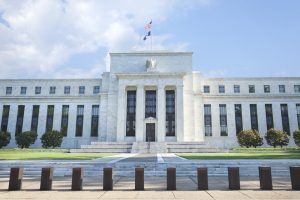The FOMC Expects a Rate Hike “Fairly Soon” – Here’s What We Think That Means. February 27, 2017.
This is an excerpt from today’s Sevens Report. You can get a free 2-week trial and see for yourself how the Sevens Report can give you fresh talking points for your client conversations, and help you outperform your peers. Read on to see our predictions for when the FOMC will announce the next rate hike.
There were only two notable economic events last week and neither were particularly positive for stocks (although they weren’t outright negatives). For weeks, the economic data has been supporting markets through consistent policy disappointment from Washington, so it’s notable that last week the data wasn’t particularly supportive, and incremental disappointment finally weighed slightly on stocks. Going forward, with policy outlook continuing to dim, data will need to be consistently good to further support this rally.
Last Week
Looking at last week’s data, the February flash PMIs (both manufacturing and service sector) were surprisingly disappointing. The flash manufacturing PMI declined to 54.3 vs. (E) 55.5, which was a surprise miss given the very strong Empire and Philly surveys from two weeks ago. The flash services PMI also missed estimates at 53.9 vs. (E) 55.9, again posting a surprise decline. Additionally, most of the details in these reports, including New Orders in the manufacturing PMI (which is a leading indicator), also fell. Meanwhile, the manufacturing input price index rose slightly while the selling price index declined slightly, implying margin compression in the manufacturing sector.
Now, to be fair, the absolute levels of these two PMIs remain high and by no means does the mild pullback imply a loss of economic momentum. However, the market needs consistently better data to offset the noise from Washington, and that didn’t happen last week.

The FOMC expects another rate hike “fairly soon,” but it is unlikely to be next month.
The FOMC minutes were the other notable economic event last week, and while the minutes were taken as slightly dovish by the currency and bond markets, in reality they only confirmed that May is now (in our opinion) the next likely date for a rate hike.
The key phrase in the minutes was the FOMC expected another rate hike “fairly soon.” The reason that was taken as slightly dovish is because fairly soon isn’t the “next meeting” (that’s what has appeared in the FOMC minutes before the previous two rate hikes). The takeaway is that a March hike is unlikely, though that’s not incrementally dovish because the market wasn’t expecting a March rate hike anyway. If we get a strong inflation number this week and a strong jobs report Friday, odds of a March rate hike could creep closer to 50% from the current 22% (and that could be a headwind on stocks).
This Week
This will be a busy and important week for the economy as we get some critical data on growth and inflation, and if stocks can maintain this rally, the former needs to be strong and the latter doesn’t. The most important number this week is the PCE Price Index contained in Wednesday’s Personal Income and Outlays report. February CPI and PPI were both much stronger than expected, and if the Core PCE Price Index (which is the Fed’s preferred measure of inflation) moves close to 2% (currently at 1.6%) then we will see expectations for a March rate hike increase, and that will send Treasury yields higher and send the dollar higher—and that will put a headwind on stocks.
The next most important number this week is the ISM Manufacturing PMI, out Wednesday. Normally, this would be the most important number of the week, but even if this confirms last week’s flash PMI and pulls back a bit from January, it’s still a very high absolute level and it will take several months of declines before anyone would get worried about activity in the manufacturing sector. Nonetheless, it is still a critical number and if it’s soft we could see a bit of stock weakness.
There are other notable reports this week including Durable Goods (today) and the services PMI (Friday). Finally, revised Q4 GDP comes Tuesday, and analysts are still looking for around 2% growth (Q4 GDP was 1.9% in the advanced look last month). As we said, all the data is important given strong data has helped offset growing policy worries, so these number meeting or beating estimates will be generally supportive. Bottom line, data needs to stay good and inflation needs to stay tame in order to support this market, because Washington policy expectations are a growing headwind.
Join hundreds of advisors from huge brokerage firms like Morgan Stanley, Merrill Lynch, Wells Fargo Advisors, Raymond James and more… see if the Sevens Report is right for you with a free 2 week trial.








